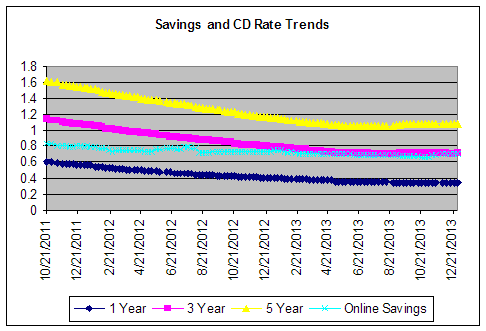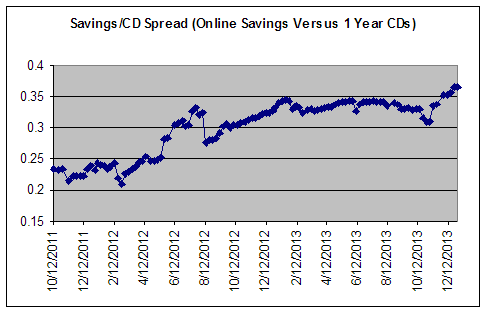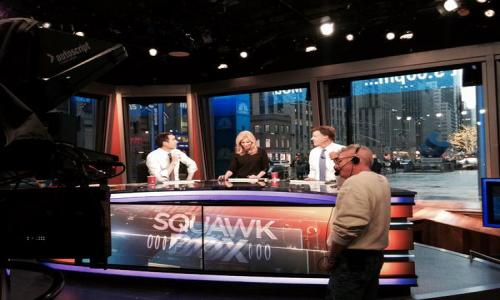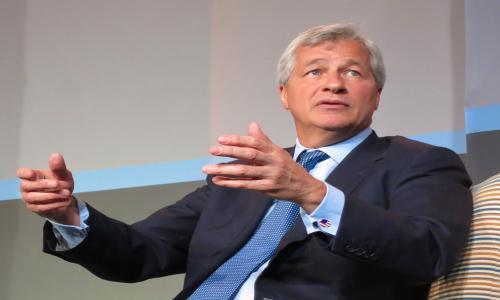Happy New Year! I thought I would use the inspiration provided by the New Year to take a look ahead and make some projections about what I expect to happen to rates over the next 12 months. First, let's see what I predicted at the beginning of last year and where things wound up. Last year I said:
"Savings rates will continue to drift lower for the next 12-18 months before beginning to move higher. How high and how fast they move will depend on the government's ability to stop bickering and put a sound budget in place, the continuation of a recent economic uptick, technological advances, and the ability of Europe to put its woes behind it and resolve its fiscal problems."
This is pretty much what happened. Longer-term CD rates did begin to move up slightly in June as the Fed began to signal an end to its taper program but savings accounts and shorter-term CDs stayed pretty flat. Overall, as the chart below shows, rates declined or remained flat.
One year average CD rates started the year at 0.405% APY and finished the year at 0.348% APY. Five year CDs averages started at 1.159% APY and despite the second year rally, finished down at 1.083% APY. For the second straight year, online savings accounts held their own, dropping the last, from 0.737% APY to 0.712% APY.

Looking Ahead to 2014
The biggest rate news for 2014? We are in a rising rate environment. Rates are not going to spike to 5% anytime soon, but barring a major calamity they are moving up. Why do I say this? Let's look at the general rate environment.
General rate environment
Six reasons interest rates will rise in 2014:
- The economy is growing and is expected to gain additional momentum in 2014. American finances have improved and housing sales continue to be strong. In addition, the drag from cuts in government spending will abate with the new budget passed in December 2013.
- Europe has stabilized and started to grow. Europe didn't fall apart in 2013 as many expected and some countries, such as the UK, have actually begun to grow again. Europe is a huge market and a healthier continent on the other side of the Atlantic will help boost growth.
- Government paralysis bottomed out and is improving. The government shutdown in November marked a low point for government paralysis and since then both Republicans and Democrats have shown a bit more flexibility, even agreeing to a two year spending resolution. Keeping the government out of the headlines is a positive boost to the economy.
- The Fed has committed to keeping rates exceptionally low as long as unemployment is above 6 1/2 percent. It currently stands at 7.0% and by the middle of 2014 will reach the 6.5% range. The only caveat to this is that the Fed recently announced it may keep rates low even if unemployment hits its goal, if inflation remains below 2%. The inflation rate through November 2013 was 1.2% (December 2013 data has not been released yet).
- I project steady but moderate economic growth of around 2.5% in 2013.
- The banking sector has largely recovered from the crash of 2008. The sector is now better capitalized. According to FDIC data, equity to assets in the banking sector has increased from 9.36% in December of 2008 to 11.17% in September 2013. In addition, the average Texas ratio of all U.S. banks, a signal of banking sector distress has dropped to a five year low of 14.21% after being as high as 22%. As the economy improves and rates rise, banks will begin to lend more aggressively, further stimulating growth.
There are still a few headwinds to the global economy that will constrain growth and rates.
- Deleveraging. This refers to both financial firms and individuals reducing debt. In the process of doing this, money that would have been borrowed and spent on purchasing cars, houses, and other goods is instead spent on paying down debt. This saps demand and economic growth. According to Gary Shilling, deleveraging after a financial crisis generally takes 10 years, leaving us with four more years to go. I think this analysis makes a lot of sense and until we have worked off the binge of debt acquired in the 2000s it's hard to see very robust growth.
- Demographic trends are unfavorable. Unfortunately, the United States has entered a demographic slide. As the large baby boom generation ages and retires, this puts a large strain on the country's productivity and spending. I believe that demographics is a general driver of economic development. A young population lifts all boats. An aging one will leave quite a few boats stranded and make it difficult for the others. Japan and Europe have even worse demographic problems and their economies reflect that. As China's population ages, look for its growth to ebb. This demographic slide will be a factor for the next ten to twenty years, not stopping growth, but certainly acting as a headwind.
When you put all of this together, I see an improving U.S. and world economy, held back by demographics as well as a lingering hangover from the debt binge of six years ago as well as an uncertain U.S. government fiscal situation.
My outlook: Savings account rates will stay flat through 2014 although online savings account rates may increase by 20-30 percentage points. I project the highest online savings account next year will yield 1.75% APY. Short term savings rates will edge up slightly but longer term CDs (3-5 year) will continue the trend we have seen over the past six months and continue to move up. I expect we'll see the biggest increases in these longer duration CDs. We already have one credit union (PenFed) offering a 3%+ APY five year CD. Look for this trend to continue.
There is always a chance of a major shift in rates should an unforeseen event occur - like 9/11. Since these are unpredictable, I just say that savers and investors should always be aware of these types of risks. In general, cash in a FDIC insured account is must more immune to these types of shocks than money invested in the stock or bond markets.
Savings Accounts or CDs?
Like last year, the data still show that opening a savings account is a better bet than a 1-3 year term CD and I expect this to hold through 2013. In fact, as the chart below shows, the spread between the average interest rate on an online account and a one year CD is at an all-time high. Longer maturity CDs (3 years +) though are becoming more competitive and while I warned savers away from them last year, now I think they are something to consider, especially if you can get a CD with a rate above 3%.

So for now, here are my recommendations:
For money you want to keep liquid, go with online savings accounts. They offer better rates than 1-3 year CDs and have shown good rate stability over the past year.
For longer-term money, look to open 4-5 year CDs at local community banks or larger credit unions. BestCashCow research has shown that community banks and larger credit unions offer the most competitive rates on longer-maturity CDs.
I believe this is the best and easiest strategy for keeping your cash liquid and maximizing your savings over the next year.
Earn the Most You Possibly Can
For the fifth straight year, yields on savings and CDs are pretty abysmal. We like to say the best you can do is make the best out of a bad situation. By shopping around, a saver can earn an extra half to full percentage point. On $100,000, that's $1,000 in extra cash per year. Remember, even in today's environment, there is competition for your cash.
As always, I welcome your thoughts and comments.












Add your Comment
or use your Google account
or use your BestCashCow account